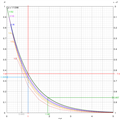i know its more a math question, maybe out mql forum range but let me ask, if i have
a system with, let's say, 80% accuracy, what's the probability of miss 2 times in sequence?
thanks
20/100 * 20/100 = 1/5 * 1/5 = 1/25 = 0.04 = 4% chance
it's considering last month, i know there are bad spread conditions sometimes, but my question was really not considering them, just the probability of 2 consecutive losses with 80% winning average , but thas was already solved above by James , anyway thank you for your answer
you can lose 2 trades first then win 8
maybe that 2 trades is enough to burst the account? (you did not specify risk reward)
If a trader has 80% win rate, with expected gain 100% leveraged for each trade, lose 1 trade is ok, on 20% chance, but 2 would be really against the odds, only 4%,
as james stated on his equation,so you just need to allways trade 50%, expecting 100% from this 50%, and if you get a loss, you trade the 50% and get a
full recover to next winning trades, so you are in a win win situation, right, because only 4% chance of repeated loss is very rare
The formula is Bernoulli trial. That is probability to get success (known to have probability p) k times from n independent trials is:
P(k,n) = Cn(k) * pow(p, k) * pow( (1 - p), (n - k))
where Cn(k) is Binomial coefficient - n! / (k! (n - k)!), where ! is factorial.
For the trivial case of taking k = 2 times from n = 2 trials, you'll get:
P(2,2) = p * p = 0.8 * 0.8 = 0.64
to get 2 wins in a row. And 0.2 * 0.2 = 0.04 to have 2 losses in a row, but all this seems too artificial (unreal) because the sequence is most likely consisting of larger number of trades, so the extended formula should be used.

- en.wikipedia.org
Stanislav Korotky: to get 2 wins in a row. So the probability to have 2 losses in a row is 1 - 0.64 = 0.36.
| 36% is the probability that you get one win/one loss or one loss/one win or two losses. |
| 36% is the probability that you get one win/one loss or one loss/one win or two losses. |
I've edited my post.
BTW, why do you break formatting in your answers on the forum so, that citation with a question and your reply are located side by side in a single paragraph?
it's 36% or 4% the probability of 2 consecutive losses?
and if its 36% of two losses, how is that? because its more than 20% initial missing margin for every trade.
it's 36% or 4% the probability of 2 consecutive losses?
and if its 36% of two losses, how is that? because its more than 20% initial missing margin for every trade.
a trader doesn't need that baloney, probability analysis is purely theoretical.
http://www.mathgoodies.com/lessons/vol6/dependent_events.html
http://www.mathgoodies.com/lessons/vol6/independent_events.html
that will give you a start.
this is what will make or lose you money:
x = wins, y = losses, z = total trades, n = a decimal-----(x + y)/ z = n, then n * 100 = p/l as a %. higher the % = more $$$$$. K.I.S.S., you can do that on a simple spreadsheet and update in real time. don't follow Bernoulli down a rabbit hole.
Tom
I'll disagree with that. The OP's question relates to how much he can risk (even if he didn't state it.) What he doesn't understand is that the problem is combinatorial in nature.
For the next two trials 4%. For three trials it doubles because there are two chances. For 10 trades, one could have 2 consecutive losses on trade#1&2, #2&3, #3&4, 4&5, 5&6, 6&7, 7&8, 8&9, or #9&10. Nine different ways essentially. The probability of 2 consecutive losses in 10 trades (0.20^2)*9 or 36% In 25 trades you will almost certainly have 2 in a row.
The probably of 4 consecutive losses in 100 trades is (0.20^4)*(100-9+1) 16%
It's not theoretical, it's fact, and is the nature of drawdown. That is why you can't trade more than a small percent per trade. Risk 5% you will have 20% DD every 100 trades.
| Consecutive losses | 2 | 3 | 4 | 5 | 6 | 7 | 8 | |
| no trials | 2 | 4.00% | ||||||
| 3 | 8.00% | 0.80% | ||||||
| 20.00% | 4 | 12.00% | 1.60% | 0.16% | ||||
| 5 | 16.00% | 2.40% | 0.32% | 0.03% | ||||
| 10 | 36.00% | 6.40% | 1.12% | 0.19% | 0.03% | 0.01% | 0.00% | |
| 25 | 96.00% | 18.40% | 3.52% | 0.67% | 0.13% | 0.02% | 0.00% | |
| 100 | 396.00% | 78.40% | 15.52% | 3.07% | 0.61% | 0.12% | 0.02% | |
| 500 | 1996.00% | 398.40% | 79.52% | 15.87% | 3.17% | 0.63% | 0.13% | |
| 1000 | 3996.00% | 798.40% | 159.52% | 31.87% | 6.37% | 1.27% | 0.25% |
- Free trading apps
- Over 8,000 signals for copying
- Economic news for exploring financial markets
You agree to website policy and terms of use
i know its more a math question, maybe out mql forum range but let me ask, if i have
a system with, let's say, 80% accuracy, what's the probability of miss 2 times in sequence?
thanks